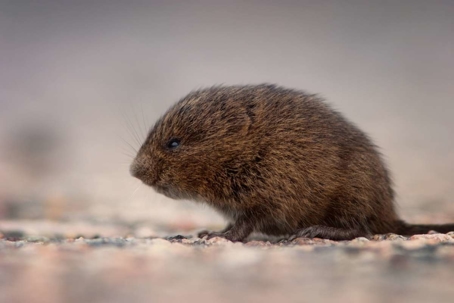Do Voles Bite?
Voles are small, shy rodents that primarily feed on plants and seeds. Unlike more aggressive rodents like rats, voles are generally not prone to biting humans or pets, but there are specific situations in which a bite could occur:
Handling or Cornering: If a vole is picked up, restrained, or trapped, it may bite defensively. They bite mainly out of fear, not aggression.
Protecting Themselves: A vole may bite if it feels threatened, especially if it is trapped in a pet’s mouth or accidentally caught. Mother voles protecting their young may act defensively if directly handled.
Pets Interacting with Voles: Dogs or cats that try to catch or play with a vole may get bitten in the process. Most bites occur during a chase or when a vole is cornered by a pet.
Injured or Sick Voles: A vole that is sick, stressed, or injured may be more prone to biting than a healthy one.
Voles are not naturally aggressive toward humans and will usually try to flee rather than fight. Bites are almost always defensive and rare.
Vole Bites
Vole bites are relatively uncommon, but they do carry some potential risks. Because voles are wild rodents, any bite should be treated seriously. Here are some of the risks associated with vole bites:
Infection
Bacterial Infection: Vole mouths can carry bacteria such as Streptococcus, Staphylococcus, and Pasteurellaspecies. A bite can introduce these bacteria into the skin, potentially causing localized infection.
Signs to watch for: Redness, swelling, warmth, pus, or increased pain around the bite site.
Rabies (Extremely Rare)
While technically possible, voles are not common carriers of rabies, and documented cases are virtually nonexistent. The risk of rabies from a vole bite is exceedingly low.
Tetanus
As with any puncture wound from an animal bite, tetanus is a potential concern if your vaccinations are not up to date.
Action: Ensure your tetanus booster is current (within the last 10 years, or 5 years for a high-risk wound).
Allergic Reactions
Some individuals may develop an allergic reaction to rodent saliva.
Symptoms: Swelling, itching, redness beyond the immediate bite, or more rarely, systemic reactions.
Zoonotic Diseases
Voles can carry diseases transmissible to humans (zoonoses), such as hantavirus or leptospirosis, but transmission via bite is extremely uncommon. Most transmission occurs via contact with urine, feces, or nesting material rather than bites.
Risk level: Very low, but if symptoms like fever, muscle aches, or unusual fatigue appear after a bite, see a doctor.
The primary risk of a vole bite is bacterial infection from the puncture wound. Rabies, tetanus, and zoonotic disease are possible but extremely rare.
What Do Vole Bites Look Like?
A vole bite is generally a small but noticeable puncture wound because voles have sharp, chisel-like incisors. Here’s what vole bites look like:
Puncture Marks: Usually two small punctures from the upper and lower incisors, often very close together. They may look similar to a tiny pair of holes or pinpricks.
Surrounding Skin: Mild redness or irritation around the puncture points. Slight swelling is common, especially if the bite occurred on a hand, finger, or other soft tissue area.
Bleeding: Usually minimal; voles are small rodents and cannot deliver deep or heavy bites. Bleeding tends to be light and can often stop with basic first aid.
Possible Infection Indicators (If Not Treated): Redness spreading beyond the bite site. Swelling, warmth, or tenderness. Pus or fluid forming in the wound. Pain that worsens over time instead of improving.
Other Symptoms: Minor bruising around the bite is possible but rare. Some people may experience itching or mild irritation as the wound heals.
Vole bites are usually superficial and defensive, not aggressive, but because they are wild rodents, cleaning the wound promptly is crucial to prevent bacterial infection.
What To Do About Vole Bites
If you or a pet get bitten by a vole, the risk of serious illness is low, but proper care is important to prevent infection and complications. Here’s what to do if you get bitten by a vole:
Immediate First Aid
Wash the Wound: Rinse thoroughly under running clean water for at least 5–10 minutes. Use mild soap to gently clean the area. Avoid scrubbing harshly, which can damage tissue.
Stop Bleeding: Apply gentle pressure with a clean cloth or sterile gauze. Most vole bites bleed very little and should stop quickly.
Apply Antiseptic: Use an antiseptic solution (like iodine or hydrogen peroxide) or an antibacterial ointment. This reduces the risk of infection from bacteria in the vole’s mouth.
Cover the Bite: Apply a sterile bandage to keep the wound clean and protected. Change the dressing daily or if it becomes wet or dirty.
Monitor for Signs of Infection
Redness spreading around the bite
Swelling, warmth, or tenderness
Pus or unusual discharge
Increasing pain
Fever or general feeling of illness
If any of these occur, see a healthcare professional immediately. They may prescribe antibiotics.
Tetanus Consideration
Ensure your tetanus vaccination is up to date.
If you haven’t had a booster in the last 10 years (or 5 years for deep or dirty wounds), consult your doctor.
Rabies Risk
Voles almost never carry rabies, so post-exposure rabies treatment is generally not needed.
Only consider it if the vole appeared unusually aggressive or sick.
Allergic Reactions
Some people may develop itching, hives, or swelling.
Mild reactions can be treated with antihistamines, but severe reactions require immediate medical attention.
Pet Considerations
If a vole bites a dog or cat, clean the wound similarly and monitor for infection.
Contact a vet if the bite is deep, bleeding persists, or signs of infection appear.
The most important steps are immediate washing, antiseptic application, and monitoring for infection. Most vole bites are minor and heal without complications if treated promptly.

